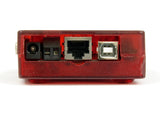New applications should consider the newer T7 or T7-Pro over the UE9 or UE9-Pro. The T7 family is generally superior at a lower price.
Analog Inputs:
The LabJack UE9 has 14 external analog inputs (AIN0-AIN13). AIN0-AIN3 are available on screw terminals and also on the DB37 connector. All 14 analog inputs are available on the DB37 connector.
Each analog input can be configured individually as unipolar (four ranges from 0-5 volts to 0-0.625 volts) or bipolar (±5 volts). Analog input resolution is 12-bits at max speed (12 us conversion time), increasing up to 16-bits at slower speeds (2.7 ms conversion time).
Command/response (software timed) analog input reads typically take 1.5+ ms depending on number of channels and communication configuration. Hardware timed input streaming has a maximum rate that varies with resolution from 250 samples/s at 16-bits to 50+ ksamples/s at 12-bits.
The UE9-Pro has all the features of the normal UE9 with the addition of an auxiliary low-speed hi-resolution (24-bit) sigma-delta ADC. This converter takes about 125 ms per sample and provides an effective resolution of about 20-bits (18-bits noise free) over the 0-5 or +/-5 volt ranges. Linearity and accuracy are also improved compared to the normal converter.
For more information see the UE9 Datasheet. For more information about the analog inputs see Section 2.7 - AIN and Appendix A. For data rate information see Section 3.1 - Command/Responseand Section 3.2 - Stream Mode.
Analog Outputs:
The LabJack UE9 has 2 analog outputs (DAC0 and DAC1) that are available both on screw terminals and the DB37 connector. Each analog output can be set to a voltage between 0 and 4.9 volts with 12-bits of resolution. The analog outputs are based on a true voltage reference.
The analog outputs are updated in command/response mode, with a typical update time of 1.5-4.0 ms depending on communication configuration.
For more information see the UE9 Datasheet. For more information about the analog outputs see Section 2.8 - DAC and Appendix A. For data rate information see Section 3.1 - Command/Response.
Digital I/O:
The LabJack UE9 has 23 digital I/O channels which can be individually configured as input, output-high, or output-low. 8 of these lines are called flexible digital I/O (FIO) and can be software configured as up to 6 timers and 2 counters.
The first 4 FIO are available on screw terminals and the DB37 connector. All 8 FIO and 3 MIO are available on the DB37 connector, and 8 EIO and 4 CIO are available on the DB15 connector.
Command/response (software timed) reads/writes typically take 1.5-4.0 ms depending on communication configuration. The digital inputs can also be read in a hardware timed input stream where up to 16 inputs count as a single stream channel.
For more information see the UE9 Datasheet. For more information about the digital I/O see Section 2.9 - Digital I/O and Appendix A. For data rate information see Section 3.1 - Command/Response and Section 3.2 - Stream Mode.
Timers:
Up to 6 FIO can be configured as timers. The timers are very flexible, providing options such as PWM output, pulse timing, pulse counting, and quadrature input.
For more information see the UE9 Datasheet. For more information about the timers see Section 2.10 - Timers/Counters and Appendix A.
Counters:
Up to 2 FIO can be configured as 32-bit counters.
For more information see the UE9 Datasheet. For more information about the counters see Section 2.10 - Timers/Counters and Appendix A.
I/O Protection:
All I/O lines on the UE9 are protected against minor overvoltages. The AIN lines can withstand continuous overvoltage of ±15 volts, the FIO lines can withstand up to ±10 volts, while the EIO/CIO/MIO lines can withstand up to ±6 volts.
Power Supply:
Power can be provided by the USB cable or an external 5 volt supply (included). When only Ethernet is connected, and an isolated power supply is used (such as the included wall-wart), the entire UE9 is electrically isolated.
High Channel Count Applications:
By using USB hubs or Ethernet switches, many LabJacks can be interfaced to a single PC, providing an inexpensive solution for low-speed high channel count applications.
Modbus:
Modbus is an industry standard command/response protocol for data acquisition and control equipment. The UE9 supports Modbus/TCP in hardware, so any software that supports Modbus/TCP can talk to the UE9 with no further software/drivers required. (More Info)
Wireless Data Acquisition:
Combining the UE9 with a standard 802.11 wireless Ethernet bridge or access point ($50-$200 from any computer retailer) provides inexpensive wireless data acquisition. Applications include high-speed continuous wireless data acquisition, long distance remote sensing and control, or PDA based data acquisition. (More Info)


